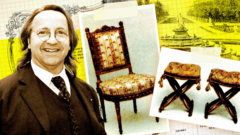Two renowned craftsmen faced charges of fraud for selling counterfeit 18th-century chairs, once believed to have belonged to French royalty. The scandal raises concerns about authenticity verification in the antiques market.**
Royal Fraud: The Counterfeit Chairs That Deceived Versailles**

Royal Fraud: The Counterfeit Chairs That Deceived Versailles**
A scandal unfolds as experts admit to creating fake royal furniture, fooling even the Palace of Versailles and high-profile collectors.**
In the early 2010s, the French antiques market was agog with the appearance of two exquisite chairs, thought to be invaluable relics from the Palace of Versailles. Attributed to celebrated 18th-century carpenter Nicolas-Quinibert Foliot, these chairs were believed to have graced the life of Marie Antoinette, the last queen of France. Their status as "national treasures" was solidified when the French government, responding to Versailles' request, sought to acquire them, but they were ultimately sold to Qatari Prince Mohammed bin Hamad Al Thani for a staggering €2m (£1.67m).
These chairs were just part of a larger ensemble of royal furniture that had flooded the antiques market, including pieces purportedly belonging to other royal figures like Madame du Barry and King Louis XVI's sister, Princess Élisabeth. Many of these items found their way into the collection at Versailles; however, the 2016 revelation that they were all forgeries led to widespread scandal within the French antiques community.
Prominent antiques expert Georges "Bill" Pallot, along with cabinetmaker Bruno Desnoues, found themselves embroiled in legal troubles after a nine-year investigation revealed the items' authenticity issues. They were charged with fraud and money laundering, with their trial commencing in Pontoise, France. Pallot and Desnoues confessed to their crimes, while others, including Laurent Kraemer, director of Galerie Kraemer, faced allegations of gross negligence for their role in the deceptive sales.
The scheme, as Pallot recounted in court, began lightheartedly in 2007 as an attempt to replicate an 18th-century armchair, which quickly spiraled into a full-scale fraud operation. Both men fashioned intricate copies of historical chairs, artfully aging the materials and employing vintage stamps to create the veneer of authenticity. Their expert craftsmanship convinced auction houses, and the chairs infiltrated reputable galleries, eventually making their way into royal collections.
Prosecutors estimated Pallot and Desnoues profited over €3m through the scheme, leveraging their formidable knowledge of royal furniture archives to circumvent detection. Meanwhile, senior members of the antiques community called this deception a wake-up call for stricter regulations in the art market.
The investigation commenced after French authorities took note of the suspicious wealth of a handyman linked to the fraudulent transactions. Charges against some involved parties were dropped, but the case continues to shake the foundations of the antiques industry, leading to a request for heightened scrutiny of authenticity checks. Legal experts argued that the failure of galleries like Kraemer to ensure the legitimacy of the items sold represents a significant issue that calls for reform.
As the trial progresses, the repercussions of this scandal loom large over the heritage of French antiquities, prompting the need for vigilance in authenticity verification practices moving forward. The fallout from this high-profile case serves as a stark reminder of the challenges that face collectors, experts, and institutions when it comes to safeguarding the treasures of the past.
















